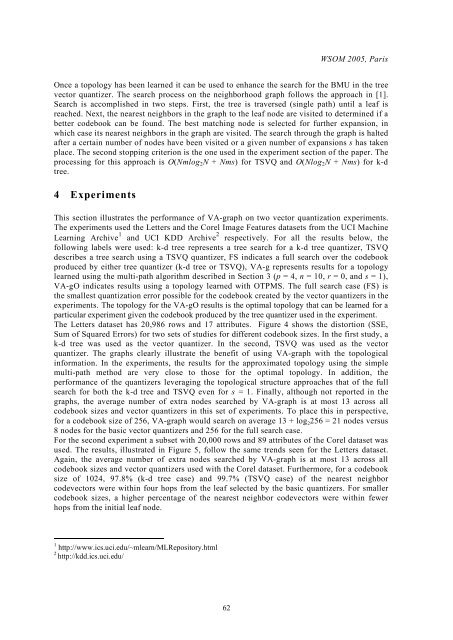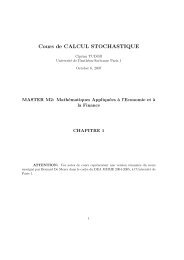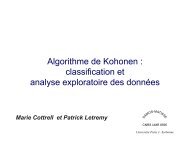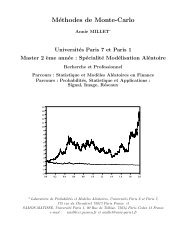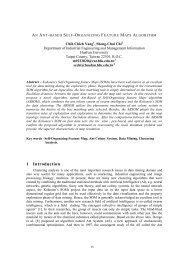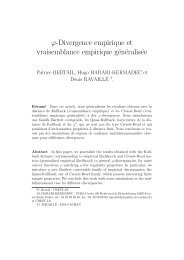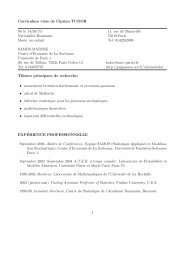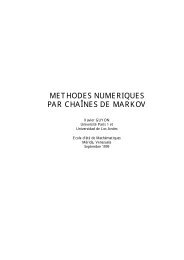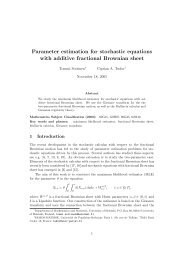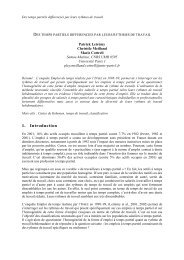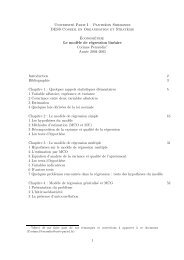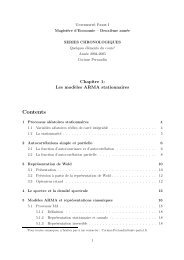Fast vector quantization with topology learning
Fast vector quantization with topology learning
Fast vector quantization with topology learning
You also want an ePaper? Increase the reach of your titles
YUMPU automatically turns print PDFs into web optimized ePapers that Google loves.
WSOM 2005, Paris<br />
Once a <strong>topology</strong> has been learned it can be used to enhance the search for the BMU in the tree<br />
<strong>vector</strong> quantizer. The search process on the neighborhood graph follows the approach in [1].<br />
Search is accomplished in two steps. First, the tree is traversed (single path) until a leaf is<br />
reached. Next, the nearest neighbors in the graph to the leaf node are visited to determined if a<br />
better codebook can be found. The best matching node is selected for further expansion, in<br />
which case its nearest neighbors in the graph are visited. The search through the graph is halted<br />
after a certain number of nodes have been visited or a given number of expansions s has taken<br />
place. The second stopping criterion is the one used in the experiment section of the paper. The<br />
processing for this approach is O(Nmlog 2 N + Nms) for TSVQ and O(Nlog 2 N + Nms) for k-d<br />
tree.<br />
4 Experiments<br />
This section illustrates the performance of VA-graph on two <strong>vector</strong> <strong>quantization</strong> experiments.<br />
The experiments used the Letters and the Corel Image Features datasets from the UCI Machine<br />
Learning Archive 1 and UCI KDD Archive 2 respectively. For all the results below, the<br />
following labels were used: k-d tree represents a tree search for a k-d tree quantizer, TSVQ<br />
describes a tree search using a TSVQ quantizer, FS indicates a full search over the codebook<br />
produced by either tree quantizer (k-d tree or TSVQ), VA-g represents results for a <strong>topology</strong><br />
learned using the multi-path algorithm described in Section 3 (p = 4, n = 10, r = 0, and s = 1),<br />
VA-gO indicates results using a <strong>topology</strong> learned <strong>with</strong> OTPMS. The full search case (FS) is<br />
the smallest <strong>quantization</strong> error possible for the codebook created by the <strong>vector</strong> quantizers in the<br />
experiments. The <strong>topology</strong> for the VA-gO results is the optimal <strong>topology</strong> that can be learned for a<br />
particular experiment given the codebook produced by the tree quantizer used in the experiment.<br />
The Letters dataset has 20,986 rows and 17 attributes. Figure 4 shows the distortion (SSE,<br />
Sum of Squared Errors) for two sets of studies for different codebook sizes. In the first study, a<br />
k-d tree was used as the <strong>vector</strong> quantizer. In the second, TSVQ was used as the <strong>vector</strong><br />
quantizer. The graphs clearly illustrate the benefit of using VA-graph <strong>with</strong> the topological<br />
information. In the experiments, the results for the approximated <strong>topology</strong> using the simple<br />
multi-path method are very close to those for the optimal <strong>topology</strong>. In addition, the<br />
performance of the quantizers leveraging the topological structure approaches that of the full<br />
search for both the k-d tree and TSVQ even for s = 1. Finally, although not reported in the<br />
graphs, the average number of extra nodes searched by VA-graph is at most 13 across all<br />
codebook sizes and <strong>vector</strong> quantizers in this set of experiments. To place this in perspective,<br />
for a codebook size of 256, VA-graph would search on average 13 + log 2 256 = 21 nodes versus<br />
8 nodes for the basic <strong>vector</strong> quantizers and 256 for the full search case.<br />
For the second experiment a subset <strong>with</strong> 20,000 rows and 89 attributes of the Corel dataset was<br />
used. The results, illustrated in Figure 5, follow the same trends seen for the Letters dataset.<br />
Again, the average number of extra nodes searched by VA-graph is at most 13 across all<br />
codebook sizes and <strong>vector</strong> quantizers used <strong>with</strong> the Corel dataset. Furthermore, for a codebook<br />
size of 1024, 97.8% (k-d tree case) and 99.7% (TSVQ case) of the nearest neighbor<br />
code<strong>vector</strong>s were <strong>with</strong>in four hops from the leaf selected by the basic quantizers. For smaller<br />
codebook sizes, a higher percentage of the nearest neighbor code<strong>vector</strong>s were <strong>with</strong>in fewer<br />
hops from the initial leaf node.<br />
1 http://www.ics.uci.edu/~mlearn/MLRepository.html<br />
2<br />
http://kdd.ics.uci.edu/


